STK Pro, STK Premium (Air), STK Premium (Space), or STK Enterprise
You can obtain the necessary licenses for this tutorial by contacting AGI Support at support@agi.com or 1-800-924-7244.
The results of the tutorial may vary depending on the user settings and data enabled (online operations, terrain server, dynamic Earth data, etc.). It is acceptable to have different results.
Capabilities covered
This lesson covers the following STK capabilities:
- STK Pro
- Analysis Workbench
Overview
The following exercise is designed to introduce you to some of the ways in which you can use vectors in STK for the 3D visualization of vehicle attitude, sensor pointing, and other phenomena of interest. You will learn to configure and use, among other things, the vector-related 3D Graphics properties of a satellite, the Attitude Sphere, the 3D Attitude Graphics window, and the Vector Geometry Tool.
Video guidance
Watch the following video. Then follow the steps below, which incorporate the systems and missions you work on (sample inputs provided).
Create a scenario
- Create a scenario.
- Set the Start time to 1 Jul 2016 12:00 , and set its Stop time to 24 hours later.
Save often!
Insert a Satellite
- From the Insert Object (
 ) tool, select the Satellite (
) tool, select the Satellite ( ) object and Orbit Wizard (
) object and Orbit Wizard ( ) method. Click Insert…
) method. Click Insert… - Set the Type to Molniya. Change the name to “Satellite.” Leave all other default values.
- Click OK.
Using vectors in 3D visualization
The following exercise demonstrates how you can visualize the differences among vectors defined in different reference frames.
Showing vector graphics
STK is shipped with a great variety of vector components—axes, points, coordinate systems, angles and planes—that can be attached to objects and displayed in 3D.
- Return to the Satellite Properties and select the 3D Graphics – Vector page.
- Select the Velocity Vector in the list and select the Show check box.
- Enable the Show Label option (if it is not already checked) and select a new Color.
- Set the Scale to 0.600.
- To display the full range of options, click .
- Find the Velocity(CBF) (
 ) listed under the Satellite in the Available list. Select it.
) listed under the Satellite in the Available list. Select it. - Click .
- Since you have added the new vector to the list, STK assumes that you want to display it. Therefore, the Show option for the Velocity(CBF) vector is already selected.
- Change the Color if you wish, and enable the Show Label option, if it is not already checked.
- Click .
The upper left portion of the page contains a list of vectors and other components that can be displayed with the Satellite. The upper right portion of the page is devoted to display options pertaining to item currently highlighted in that list. The lower portion of the page is devoted to scale options which will pertain to all vector components.
The Velocity vector that you have selected is defined in a Central Body Inertial (CBI) reference frame. You will notice that the list does not include a velocity vector defined in a Central Body Fixed (CBF) Frame. However, that list is merely a subset of the available vector components.
Displaying vectors
Take a look at those vectors in the 3D Graphics window.
- In the Object Browser, right-click the Satellite and extend the Satellite menu.
- Select the New 3D Attitude Graphics Window option. The resulting window will look something like this:
- Use your mouse to zoom and rotate in this window just as you would in the 3D Graphics window.
- Now animate the scenario and observe as the two vectors you defined separate, reflecting their differing reference frames (CBF and CBI):

The 3D Attitude Graphics window has a gray background to make it more printer friendly. The window has a black background on your computer screen. The images in this tutorial do not contain the 3D Attitude Graphics window. You wanted to explain the vectors using pictures.
Vector Components are simultaneously displayed on the satellite in the 3D Graphics window. The advantage of the 3D Attitude Graphics window is that it is a simplified view: the Earth background, other scenario objects, lighting considerations, etc., are all removed.

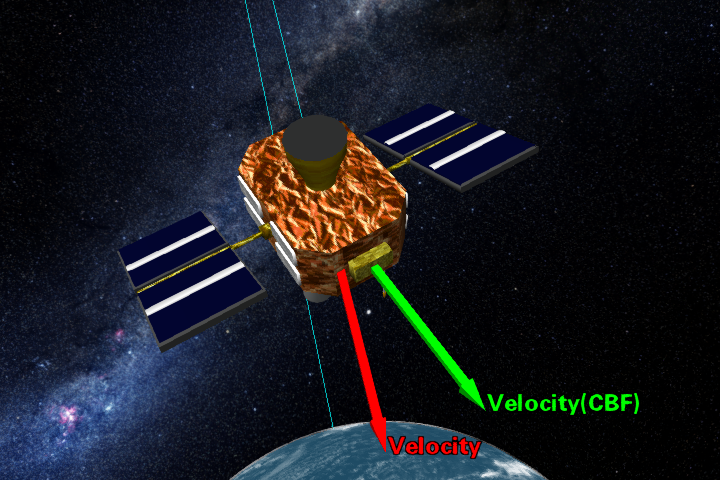
Visualizing planes
Before learning how to create new vector components, take a look at another visualization aid that STK provides: planes.
- On the Satellite Properties 3D Graphics – Vector page, select the Planes tab .
- Select the Show check box to display Body.XY Plane.
- Clear the Show Label check box.
- Set the Translucent plane value to 70.
- Click and return to the 3D Attitude Graphics window:
- Before proceeding to the next section, return to the 3D Graphics – Vector page.
- Clear the Show check box for the plane and click .
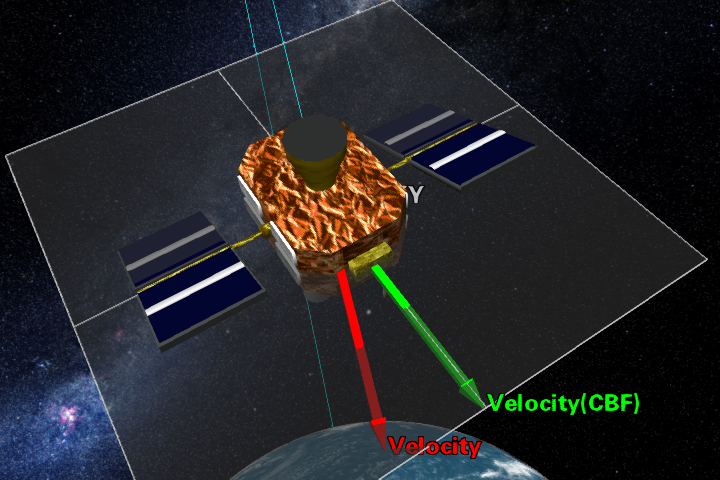
Creating a new vector
The vectors with which you have worked thus far in this tutorial are standard with STK. Now you will create a new vector. Right-click the Satellite in the Object Browser and select Analysis Workbench… Select the Vector Geometry tab.
On the left side of the panel is top-level tree showing all the objects in the STK scenario (change the Filter by option to see Central Bodies or Templates). The right-side panel shows all the vector components that are already defined for the selected object (in this case, the Satellite is pre-selected). At the bottom-right is an option Show Component Tooltips. When this option is selected, hovering the mouse over a vector component will pop up a tooltip describing exactly how the component is defined (in this case, the Velocity vector).
Also note the little lock image attached to all the vector components. This denotes vector components that come installed with STK. They are grouped into the “Installed Components” folder and cannot be edited. Vector components you created will be grouped under the “My Components” folder. You can edit them and the lock image does not appear.
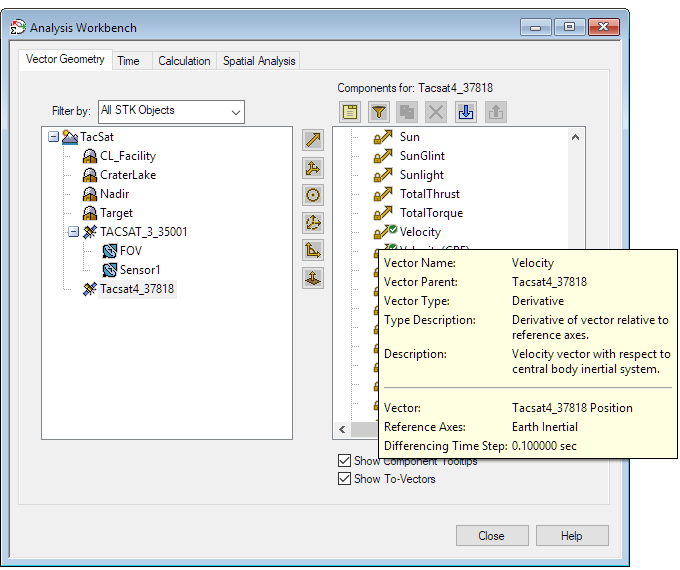
Create a velocity vector with the satellite body frame as its reference axes.
- Click the Create new Vector (
 ) button.
) button. - Use the Select… button to set the Type as Derivative.
- Name the vector Velocity(Body).
- Use the (
 ) button to set the Vector to the Satellite Position (
) button to set the Vector to the Satellite Position ( ) vector.
) vector. - Use the (
 ) button to set the Reference Axes to the Satellite Body (
) button to set the Reference Axes to the Satellite Body ( ) axes.
) axes. - Click .
The new vector appears in the “My Components” folder.
- Right-click the new Velocity(Body) vector and select Show Dependencies…
- Close the Dependency Tree.
- Close the Analysis Workbench.
- Open the 3D Graphics – Vector page of the Satellite properties.
- Click .
- Select the newly created Velocity(Body) vector. Click .
- Select the new vector, select the Show Label option (the Show option is already selected), change the Color if necessary, and click .
- The new vector now appears in the 3D Attitude Graphics window.
The “Show dependents” radio button shows everything that depends on this vector (nothing yet). The “Show constituents” radio button shows the reverse: everything this vector depends on. This information will not be explicitly used in this exercise, but you may want to make mental note of this as a new tool for understanding and troubleshooting scenarios.
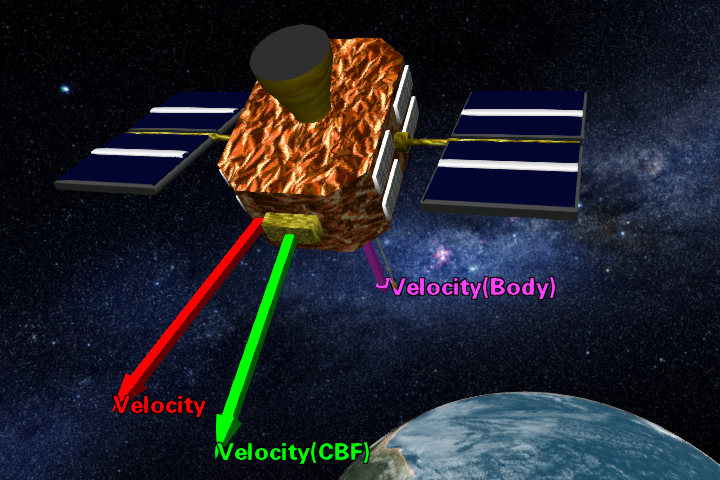
Viewing the Attitude Sphere
- Open the 3D Graphics – Attitude Sphere page of the Satellite properties.
- Select the Show check box.
- Set the Scale Value to 0.700.
- Click and look at the 3D Attitude Graphics window:
- Now return to the Attitude Sphere page and consider some of the display options presented there:
- The Sphere Color and Grid line width options control the appearance of the grid lines defining the sphere.
- The Zero Deg Color and Zero Deg line width are used to highlight the equator and prime meridian lines as desired.
- Label Type and Label Color determine the display of latitude/longitude labels on the sphere.
- The Scale is a logarithmic value controlling the size of the sphere.
- The Frame field lets you select a reference frame for the sphere display.
- The Projections area lets you display a projection of a central body limb on the surface of the sphere. As you animate, you may notice on the sphere a blue circle that changes in size. This is the Earth limb projection, on by default.

You may want to take a few minutes and experiment with these and other settings and observe the impact on the display in the 3D Attitude Graphics window.
The purpose of this exercise is not to demonstrate the many ways in which the Attitude Sphere might be useful in performing analytical or operational tasks, but merely to point to this capability and encourage you to explore it yourself. As a representation of your reference frame, the Attitude Sphere may make it easier at times to understand the velocity, position, or attitude of an object.
For example, you can use projections on the Attitude Sphere to help you analyze the velocity of a satellite relative to other bodies, such as the Earth.
- In the Projections panel, select Earth and enable the Volume option.
- Click . The Earth's projection will now display as a cone in the 3D Attitude Graphics window:
- When you are finished, clear the Show check box on the 3D Graphics – Attitude Sphere page.
- Click .

If you animate the scenario and then pause it at apogee, the Earth-defined vectors (Velocity and Velocity(CBF)) will appear at approximate right angles to the Earth projection cone, as would be expected:

Creating and displaying angles
Vectors comprise only one of six available component types that STK makes available. The others are axes, points, coordinate systems, angles, and planes. In this portion of the exercise, you will add some angles to the 3D display.
- Return to the Satellite’s 3D Graphics - Vector page and click .
- The angle you are going to add needs to be created, so click the Create new Vector… button. In this instance, “Vector” refers to a Vector Geometry component, rather than specifically a new vector.
- To change the Type, click . Expand (
 ) the options under Angle and select Between Vectors (
) the options under Angle and select Between Vectors ( ). Click .
). Click . - Name the angle “VelocityDifference.”
- Use the (
 ) button to select Satellite Velocity as the From Vector. Likewise, use the (
) button to select Satellite Velocity as the From Vector. Likewise, use the ( ) button to select Satellite Velocity(CBF) as the To Vector.
) button to select Satellite Velocity(CBF) as the To Vector. - With your Angle defined, click .
- Back on the Add Components window, select the new VelocityDifference Angle from the Available list.
- Click .
- On the Satellite’s 3D Graphics – Vector page, select the Angles tab, select the new angle and make certain that the Show Label option is disabled. Select the Show Angle Value box and, if necessary, change the Color. Click .
Look at the 3D Attitude Graphics window. Animate the scenario and observe the changes in the angle value as the vectors defining it move apart and back together:

Now that you know how to create and display angles, try adding another angle, this one between the Velocity vector and the Velocity(Body) vector (Hint: look for Velocity(Body) under the My Components section). When you finish, display the angle and check out the results in the 3D Attitude Graphics window.

Before beginning the next exercise, disable the Velocity(Body) vector and the angle.
Creating a persistent vector display
For the Velocity and Velocity(CBF) vectors:
- Clear the Show Label check box.
- Click the (
 ) button next to the Axes field and select ICRF.
) button next to the Axes field and select ICRF. - Draw at Point should indicate Satellite Center.
- Select the Show check box for Persistence, enter a Duration of 1 day (86400 sec), select Sweep as the Connect option, and select the Fade check box.
- Click and go to the 3D Attitude Graphics window. Play the animation and watch the two velocity vectors sweep out their respective disks.
For a slightly different view of the action:
- Reset the animation.
- In the 3D Attitude Graphics window, click the View From/To button located in the 3D Graphics toolbar.
- Select the Along a Direction radio button.
- Under From Position, select the Satellite.
- Under Direction, use the Vector (
 ) button to select Satellite Velocity.
) button to select Satellite Velocity. - Select the Inward radio button.
- Click . Adjust your zoom, and animate the scenario.
The Velocity vector remains fixed directly in the direction of the viewer, while the Velocity(CBF) vector sweeps out a warped disk. Use the mouse to rotate around the satellite and see that the Velocity vector has swept out a flat disk. This is expected, as these disks are drawn in an inertial frame.
Save the Scenario.
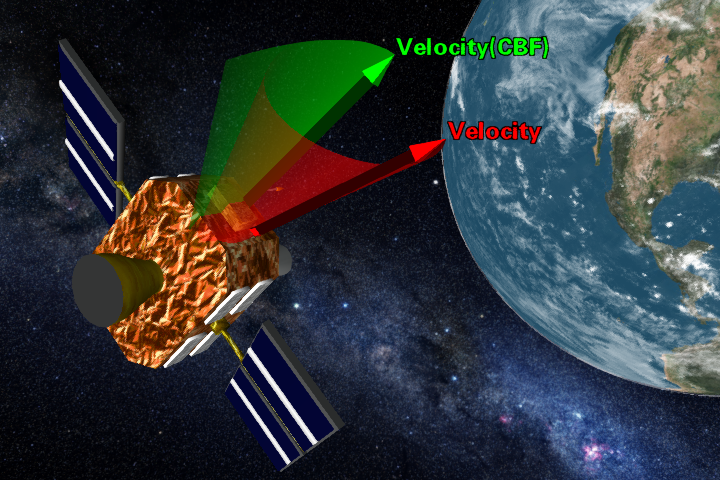
As you may recall, the satellite you created at the beginning of this tutorial has a polar orbit. On the descending side of its orbit its motion relative to the rotating Earth is in the opposite direction to its motion on the ascending side. The motion of a vector defined in a CBF framework will reflect this difference.